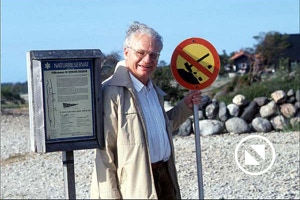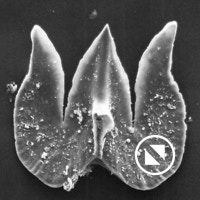In this Section...
Introduction to our 'Orsten' Research - Part 2
3. Klaus J. Müller, Bonn, the discoverer of the 'Orsten'
Klaus J. Müller, discoverer of this exceptional fauna, was born on February 6, 1923 in Berlin (photo taken in 1993 by DW). He studied geology and palaeontology at the universities of Berlin and Tübingen from 1946 to 1951. In 1951 he received his doctor’s degree and became assistant professor in Berlin in 1960. Three years later he received a call to Bonn, where he became full professor for micropaleontology until his retirement in 1988. Throughout, Klaus was interested in exceptional preservations and had contributed a lot to science by triying to find more microscopic material in exceptional preservation that provides a deep insight into palaeobiology and systematics. This was particularly silicified and phosphatized material. Klaus Müller’s first research topic were the primarily phosphatic conodonts, minute tooth-like microfossils most likely belonging to early craniote chordates that were discovered in sediments until the early Triassic, ca. 250 million years bd (2D body fossils later discovered in Cambrian to Carboniferous lagerstaetten). Klaus was one of the first to use scanning electron microscopy to study such fossils, but also worked on the internal structure of them.
In 1964 Klaus discovered phosphatic head shields of so-called phosphatocopines, tiny arthropods at these times were considered as ostracod crustaceans – later these turned out to be the sister group to Eucrustacea, i.e. far away from the ostracodes. Drawing the softer inner cuticular layer that stretched out during life of the animal from the shield margin to the central body proper, he did not, however, recognize the potential of this find. The by-chance discovery in 1975 of appendages and bodies in phosphatic and three-dimensional preservation and with this a new, formerly unknown type of preservation, when checking the residues of etched 'Orsten' limestones after a new excursion to Sweden, let him start the systematic search and exploration for Orsten arthropod fossils. Not only that Klaus had discovered the material himself during own fieldwork, but he had also developed and improved a treatment process to isolate the extremely fragile, brittle specimens. In 1979 he first published a few 'Orsten'-type preserved specimens of phosphatocopines, documented by scanning electron microscopy. There he hinted at the significance of the material for studies touching a number of subjects of carcinology.
The German Science Foundation was very interested in Klaus’s research and funded his work on ‘Orsten’ fossils (and even later the continuation of the work in Ulm by Dieter Waloszek). As one of several honours, Klaus became Foreign Fellow of the Royal Swedish Academy of Sciences in 1986, which allowed him to publish several big monographs on the faunal compotens of the 'Orsten'. Long having become emeritus professor, Klaus continued being interested in the 'Orsten' research, continued to collaborate in producing publications about the ‘Orsten’ or, for example, permitting Dieter Waloszek to take the entire collection of Orsten material to Ulm for further studies on the fossil. He also financed a trip of Andreas Braun and Dieter Waloszek in 2001 to Siberia to search for more rock material. In February 2003, just 5 days after Klaus’ 80th birthday, the Pander Society honored him with the Pander Medal for his "significant and sustained contribution to the study of conodonts". Of course he became honorary member of our C.O.R.E. group. In 2009 the German Palaeontologiocal Society dignified Klaus Müller for his lifework and his outstanding research in the field of micropaleontology with an honorary membership. Klaus Müller authored more than 100 reviewed publications, half of which deal with 'Orsten' arthropods, more and more reported also from other localities around the globe – one of Klaus’s great hopes and dreams (see chapter xxxxx).
Until his death Klaus continued to be busy in studying gemstones, a passion that had always accompanied his scientific career. Klaus died peacefully on March 12, 2010 in a seniors home in Bonn, Germany. With him, science has not only lost a great micropaleontologist, but we a good colleague and personal friend. We will miss you and are grateful for your continous generous support and of course your special sense of humour. Thank you, Klaus, for a splendid time together with you.
4. Abundance of 'Orsten' fossils
At present, we have accumulated her data mainly from the' Orsten' localities in Sweden (Västergötland and Öland) and/or from taxa, which we investigated in Bonn and Ulm. In the future, we will add also more information from other 'Orsten' fossils and according localities around the World.
The material from Swedish comprises ca. 2,000 specimens with preserved softparts plus most likely much more than 50,000 specimens of phosphatocopines, more than 2,000 of them with remains of soft parts (soft parts means preservation of cuticular structures softer than just the dorsal cuticular stiffenings, tergites or shields, namely ventral details of the body ranging from eyes and appendages to the body proper, hairs, mouth and anus etc.).
All together, the estimated number of species in 'Orsten'-type preservation exceeds 100, i.e. (>70 from Sweden). Yet, only about one half of the fossils are taxonomically described = formally named. Among them, ca. 20 species belong to in-group taxa of nemathelminth worms (round worms). Remarkably, these are only from two of the former micro-continents, i.e., from Australia and China: Australia – 1 small larva of an unknown adult cycloneuralian, i.e. a possibly basal form; several loricae, box-like envelopes of larvae, belonging to a scalidophoran species related to the tiny Loricifera and the tiny to large-sized Priapulida; 2 specimens, apparently late embryos within an egg shell of a species named as Markuelia (also known from different localities); fragments of so-called palaeoscolecids (cf. Müller & Hinz 1990), of which only the scleritic buttons of the skin were found before (e.g. Hinz et al. 1990); and from China: several new immature specimens of scalidophoran cycloneuralians.
The other fossils belong to arthropod species. A few species belong to the very early part of arthropod evolution, i.e. that part when arthropods were worm-like and soft, lacking a sclerotized cuticle, except of their claws on the ends of their legs. One is a lobopodian from Sweden; another a still unnamed tardigrade from Siberia; and several pentastomids are from the Isle of Öland (Andres 1989) and Västergötland, Sweden. Among Euarthropoda, which includes the stem species and all groups with descendants into the today's fauna, one is a larva belonging to pantopod chelicerates (claw bearers), the rest belongs to the largest marin arthropod taxon, the Crustacea, in fact species representing different evolutionary levels also here (all micro-continents). An exception is Agnostus pisiformis from the uppermost Middle Cambrian of the Baltoscandian shield (Sweden), known as calcitic shell-like head and tail shields, while the more than 100 specimens belong to early immature stages and have a phosphatized dorsal cuticle. This taxon was long regarded as trilobite related to a group of micro-trilobites, eodiscids, but the ventral morphology demonstrates affinities with the Crustacea (three specialized anterior appendages, two posterior ones of them with swimming exopods). Recently, also non-metazoan fossils could be described in the form of small threads of cyanobacterians, apparently their sheets covering the cells (Castellani et al. 2018).
Not taken the many non-phosphatized (e.g., phosphatized but primarily silicified sponge spicules, see Castellani et al. 2011) or macroscopic taxa into account, the 'Orsten' comprises, already now almost as many species as Chengjiang and Burgess, but, admittedly, only from two major taxa (which implies even more animals around because surely also others coexisted with the preserved ones). Nevertheless, The 'Orsten' covers the longest timespan of all lagerstätten yielding exceptional preservation, ranging from the Lower Cambrian to the lower Ordovician. As mentioned already above, 'Orsten' residues also contain numerous conodonts, so-called small shellies and non-phosphatized fragments, such as brachiopods and sponge spicules. Remarkably, it seems that most, if not all, pentastomids from uppermost Cambrian to Lower Ordovician strata do not co-occur with any other 'Orsten' taxa and are solid; the reasons for this are still unclear. It is also remarkable that they co-occur with conodonts. Lastly there are several macrofaunal components preserved in 'Orsten' rocks and the surrounding alum shales, such as trilobites and agnostids.
Non-'Orsten'-type fossil remains in the residues: Brachiopod, hyolith, sponge spicules, unknown surface fragment
© 2020 CORE







